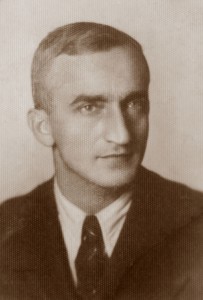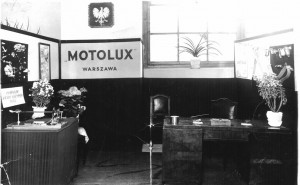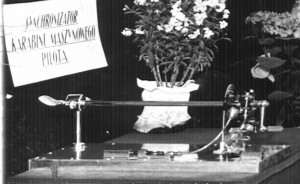Who exactly was Jan Szal? An educated engineer, a linguist having command of several foreign languages, a talented constructor, a brilliant inventor, a manager and businessman, a social activist, or perhaps an author of works concerned with astronomy? Well, he proved adept in all these domains, and his significant achievements left a lasting mark in the history of aviation.
His little known activities, shrouded in secrecy, made these accomplishments fade from memory with the passing of time, leaving this person of highest calibre in oblivion.
1899
1927
1932
A synchronizer or a device matching shots from the machine gun with the position of the propeller’s blades was another invention submitted to the Patent Office in Poland in 1934.
Shortly, it became a flagship product in the factory, being recognized and appreciated not only across Poland but abroad as well. The uniqueness of the idea developed by Jan Szal involved a new , more rational solution for the mechanism and had unparalleled attributes. For instance, unlike the previous synchronizers, this mechanism was only brought into operation while the firing bottom was pressed by the pilot, not during the whole time that the engine was running. This feature considerably prolonged its service life and reliability, preventing deterioration or failure of the mechanism which could otherwise result in shooting its own propeller.
It was also to be employed when using 3-blade propellers, the first of which were being put into operation at that time. Having passed testing in the Institute of Aviation Technical Tests, the synchronizer was approved to be utilized in the aircraft of the Polish air force. The first, JS-1 was designed for the Jupiter engine propelling PZL P-7 fighters, whereas JS-2 was used on the Mercury engine, installed in fighters PZL P-11a and P-11c fighters. An export version was tailored to the Romanian P-11b and P-11f with Gnome Rhone K9 engines. Later the JS-2 was adjusted to the Bristol Pegasus engine in the PZL-23 Karaś light bomber and the Bulgarian export version PZL-43. The model JS-37 was intended for the Wright Whirlwind J-5B engine in training planes PWS-26 and PWS-16bis, whereas JS-38 for the PZL WS Mors II (Wydra) engine in the cooperation aircraft LWS Czapla. The synchronizer – a model JS-3bis was attuned to the Gnome Rhone Mars 5 engine (with 3-blade propeller), intended for the cooperation aircraft LWS-3 Mewa. JS Synchronizers were also installed in the 1939 PZL-50 Jastrząb fighter fitted with a Bristol Mercury VII engine.
As an engineer, Szal, took part in business trips. In June 1934 he travelled with members of the Polish Aircraft Engineers Association to visit German aircraft factories. He was also involved in the Polish trade mission in Great Britain while negotiating licenced production of aircraft engines and equipment. At that time MOTOLUX received an order for Claudel-Hobson carburettors designed for the Bristol Pegasus engine, manufactured under licence in PZL WS, also intended for powering the light bomber and reconnaissance aircraft type PZL-23 Karaś and bombers PZL-37 Łoś. With the consent of the licensor, the Polish factory put some modifications in the carburettors, thereby making use of some ideas from the patent from 1927, and carburettors were designated as Claudel-Hobson MOTOLUX.
1932-38
Within a short time MOTOLUX grew from a workshop into a medium-sized enterprise. In Grabów mass-produced products were manufactured: principally synchronizers and carburettors using precision machine tools brought from Germany. While the design office and mechanical workshops used for building prototypes and manufacturing products in batch production series stayed at Huculska street in Warsaw. Products of MOTOLUX stood out as products with advanced technical complexity as well as high manufacturing precision. The factory earned renown and prestigious standing , and its brand name epitomized a top quality. The products made by MOTOLUX were reliable!
A major recipient was a national aircraft industry. These successes reverberated around the world and soon further inquiries started to flow in from abroad. The 2nd Division of the General Military Staff, that is the military intelligence had no objections to standard products being exported, so the decision was made to expand into international markets. Business expositions were held at the International Fairs in Poznań and then one year later at the Aircraft Salon in Paris.
1938
It was an early phase when aluminium and light metal alloys were being introduced and the problems of welding or soldering were faced. Thus, Jan Szal designed a unique method of welding, thus ensuring airtightness of welded joints. This new technology was a factory secret, not even disclosed when patenting the process. While constructing the gondola, a priority was given to the safety aspects enabling the crew to safely exit the gondola in life-threatening situations. Cutting-edge measures having potential for further invention were deployed. The gondola relied on a substantial amount of cutting-edge technical solutions. In essence, it was an unparalleled construction, a real masterstroke of precision engineering. Altogether three pieces were made. The related works were completed in August 1938. In the middle of the following year, two further gondolas were supposed to be ordered for the stratospheric balloon by the Argentinian aviation with the delivery date set for 1940.
The first attempt of the flight to the stratosphere was made in the Chochołowska Valley in the Tatras Mountains in Poland at night 13/14th October 1938. Due to the incorrect weather forecast and an accident with the hydrogen gas at the take-off, the flight was postponed until the next year.
1939
The latest significant projects conducted by Jan Szal, kept in secrecy, included, among others, a fast opening central lock for the parachute harness that enabled to free oneself with two hand moves in hazardous situations, e.g. over water or while crawling on the ground.
The last construction executed by Jan Szal in summer 1939 was a portable gas shelter made of duralumin sheet with a fuselage-based structure. Such a shelter with a low weight could be easily transferred from place to place without any preparation works. Related works were kept in absolute secrecy, though in summer 1939 a prototype under test was demonstrated in the closed exhibition for the army and LOPP. The serial production was projected.
Apart from the constructions and inventions, Jan Szal was has accomplishments in other domains. These included: road petrol station and its field version – functional model registered in the Patent Office in 1929, as well as technology of permanent combination of the brick wall with a reinforced concrete structure used for, among others, construction of facilities of MOTOLUX in Grabów.
Another field where Szal operated was astronomy, specifically its specialized branch – cosmogony concerned with investigating conditions for formation and development of single celestial bodies and their systems – or study of the origin of the universe. He was not alone in this passion, as he cooperated with Polish physicists involved in these studies, among others, prof. Mieczysław Wolfke, prof. Gustaw Andrzej Mokrzycki, and prof. Maksymilian Huber from the Technical University in Warsaw. He authored three publications released in Warsaw in 1930, in Bucharest in 1940 and in Warsaw in 1947 post mortem.
As a reservist officer he received an order to move the production of MOTOLUX to Kałuszyn, 4.5 km away from Mińsk Mazowiecki on 1st September in 1939. Though the dynamic political situation triggered subsequent evacuations culmination in crossing the Romanian border on 17th September 1939.
While staying in Bucharest he was repeatedly solicited to set up an identical factory, that is a local MOTOLUX business. However, faced with the growing influences of Germans and increasing fascism in Romania, he refused the proposal. Being worried about his family, he returned to Poland under occupation in 1941.
The Germans had already taken over the factory in Grabowo which changed its name into Luftfahranlagen Ost GmbH. The Germans began to push him into taking a job for the Third Reich in the position of the manager in the factory under receivership. He declined the offer and while simulating a serious disease he moved with his family to Rabka-Zaryte. There, he became involved in the underground resistance activities. In his free time he worked on the manuscript of his last publication regarding cosmology…
1942
The life of the engineer Szal was terminated in a tragic way, symbolic of the Polish generations during the war. His death was an irrecoverable loss for the family as well as for science and technology worldwide. Several years after the war, due to his wife’s efforts, he was exhumated and placed in the Military Cemetery in Powązki in the Alley of Honour in Warsaw.
Over recent years several events took place to commemorate the engineer. In the Chochołowska valley a memorial plaque was erected to commemorate the Star of Poland balloon, funded by the engineer’s daughters in October 2004. In Warsaw on the wall of the building where the former factory MOTOLUX was located, a remarkable fresco was erected, funded by the current owners of the property with the support of business, social and political communities. A neighbouring square where the factory polygon was located received the name: skwer Gwiazda Polski (Star of Poland Square). During these two ceremonies flights of hot air balloons took place. The public television TVP3 broadcast a documentary “The Star of the engineer Szal”, and the City Hall in Warsaw conferred the name of the Engineer Szal to a roundabout outside Frederic Chopin Airport in Warsaw (rondo Jana Szala).
We should hope that the preserved memorials, and recent publications will not allow the Polish constructor and inventor who made a permanent contribution to the Polish aviation history to be forgotten.
author: dr Andrzej Morgala




